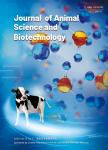GSTM3, but not IZUMO1, is a cryotolerance marker of boar sperm
GSTM3, but not IZUMO1, is a cryotolerance marker of boar sperm作者机构:Biotechnology of Animal and Human Reproduction (Techno Sperm) Unit of Cell Biology Department of Biology Institute of Food and Agricultural Technology University of Girona
出 版 物:《Journal of Animal Science and Biotechnology》 (畜牧与生物技术杂志(英文版))
年 卷 期:2019年第10卷第4期
页 面:931-941页
核心收录:
学科分类:0710[理学-生物学] 0831[工学-生物医学工程(可授工学、理学、医学学位)] 0832[工学-食品科学与工程(可授工学、农学学位)] 1004[医学-公共卫生与预防医学(可授医学、理学学位)] 0905[农学-畜牧学] 09[农学] 0906[农学-兽医学] 0703[理学-化学] 090501[农学-动物遗传育种与繁殖] 0836[工学-生物工程]
基 金:support from Ministry of Science,Innovation and Universities,Spain(Grants:RYC-2014-15581,AGL2017–88329-R and FJCI-2017-31689) European Commission(H2020-MSCA-IF-79212)
主 题:Boar Cryopreservation GSTM3 IZUMO1 ROS Sperm
摘 要:Background: Cryopreservation is currently the most efficient method for long-term preservation of mammalian gametes and is extensively used in swine artificial insemination(AI) centres. However, it is well-known that cryopreservation procedures induce changes in the water phase in both intra and extracellular compartments,which alter the content and localisation of several proteins and ends up curtailing the structural integrity of functional sperm(i.e., cryoinjuries). Alterations and deficiencies of sperm-oocyte binding proteins during gamete recognition are one of the causes of reproductive failure both in vitro and in vivo. In this sense, characterisation of cryopreservation effects upon oocyte-binding proteins of sperm, such as IZUMO1 and GSTM3, is essential when assessing the impact of this technique in swine reproduction.Results: Cryopreservation was found to induce changes in the localisation of IZUMO1 and GSTM3 in boar sperm.However, the relative content of both proteins was not altered after thawing. Furthermore, whereas IZUMO1 content was found not to be related to the cryotolerance of boar sperm, GSTM3 content was observed to be higher in poor(PFE) than in good(GFE) freezability ejaculates in both pre-frozen(1.00 INT·mm^2± 0.14 INT·mm^2 vs.0.72 INT·mm^2± 0.15 INT·mm^2;P 0.05) and post-thawed(0.96 INT·mm^2± 0.20 INT·mm^2 vs. 70 INT·mm^2± 0.19 INT·mm^2;P 0.05) samples. Moreover, GSTM3 levels were found to be higher in those spermatozoa that exhibited low mitochondrial activity, high reactive oxygen species(ROS) production, and high membrane lipid disorder postthaw(P 0.05).Conclusions: The difference in GSTM3 content between GFE and PFE, together with this protein having been found to be related to poor sperm quality post-thaw, suggests that it could be used as a cryotolerance marker of boar spermatozoa. Furthermore, both IZUMO1 and GSTM3 relocate during cryopreservation, which could contribute to the reduced fertilising capacity of frozen-thawed boar sperm.



